Croatian food made global headlines when Anthony Bourdain discovered it in 2012. Recipes, regions, restaurants, festivals, traditions and UNESCO heritage.
- This is world-class food – Anthony Bourdain
- Bourdain – This is world-class wine
- This is world-class cheese – the late, great Bourdain
- The power of the regions – is there such a thing as Croatian food?
- If it grows, celebrate – the food festivals of Croatia
- Grandma knows best – ancient recipes
- Food regions of Croatia – Slavonia
- The food regions of Croatia – Istria
- Food regions of Croatia – Dalmatia
- 5 Croatian specialties you may not have come across
- Where to find recipes for Croatian dishes?
- The Mediterranean Diet and UNESCO heritage
- Restaurants in Croatia: Michelin guide to something more simple
- Croatian gourmet tourism: where to find culinary tours?
This is world-class food – Anthony Bourdain
I remember watching the programme at the time, and I was already a veteran of 10 years in Croatia.
The Anthony Bourdain ‘No Reservations’ episode on the Travel Channel back in 2012 was totally mesmerising. It was also arguably the finest Croatian tourism promotion initiative I have ever seen. Renowned foodie Bourdain was blown away by the food, the wine, the cheese. Was Croatia finally on the global food map?
Bourdain – This is world-class wine
He was also stunned by the quality of Croatian wine, which was entirely new to him. Well, perhaps not quite entirely new. For Croatia is home to the original Zinfandel, of course, just one of 130 indigenous grape varieties which are just one small part of the incredible Croatian wine story.
This is world-class cheese – the late, great Bourdain
The final thing Bourdain paid tribute to after the food and wine in that famous sentence was cheese. This is world-class food, this is world-class wine, this is world-class cheese. And the cheese is world-class indeed. Especially from the island of Pag, whose cheeses regularly win international gold. Learn more about the fantastic cheese story from a recent TCN visit to the two main cheese factories on Pag.
And, in among all the superlatives, Bourdain forgot to mention Croatian olive oil. Another world-class performer, with Istria winning the title of best olive oil region in the world. Four years in a row!
The power of the regions – is there such a thing as Croatian food?
What exactly is Croatian cuisine?
In many ways, it does not really exist. By that I mean that there is no real national cuisine, or even national restaurants. Croatia has some very striking and very distinctive regional cuisine.
The main three are Istria, which is dominated by truffles and Italian influences; Dalmatia with its seafood and simple, fresh vegetable base; and Slavonia, with its meat dishes and fish paprika. The three have little in common with each other, and yet they are all Croatian.
One of the things that has always struck me as strange about Croatian food are the restaurants. Not only is the food very regional and territorial, but so too are the restaurants. It is relatively rare to find an Istrian restaurant in Dalmatia, or a Slavonian one in Istria. This is not due to lack of love of another region’s cuisines. Seeing the joy at the arrival of a kulen from Slavonia or truffles from Istria in our Dalmatian kitchen is proof of that.
If it grows, celebrate – the food festivals of Croatia
I have eaten some weird and wonderful things in my time on this planet, but Croatia has taken things to a higher level. The simple truth here is that if it grows, Croatians will celebrate it.
Grilled dormouse, lavender ice cream, whole frogs and even fava bean ice cream. It is grows or lives, it will be celebrated. Croatia has an incredible number of food festivals throughout the year.
As crops are seasonal, so too are the festivals. Paprika, chestnuts, lavender, dormice, snails, pumpkin, potatoes and fava beans. They all have their moments of glory. To learn more about the weird and wonderful world of Croatian food celebration, check out 25 natural food festivals not to miss.
Grandma knows best – ancient recipes
A little like the ubiquitous rakija in Croatia, each family claims to make the best version of a dish, based on an ancient family recipe, which has been handed down by generations of grandmothers.
It is one of the things I love most about living in Croatia. This adherence to past traditions continues even in the modern world, and home cooking in Croatia is as good as anywhere I have lived.
In many communities in Croatia, you will come across cooking competitions, where people are invited to submit their efforts for a local dish. Everyone goes off to cook, using their ancient grandma recipes. And there is considerable pride at winning such competitions. It is a very nice tradition.
Food regions of Croatia – Slavonia
The Food regions of Croatia – Istria
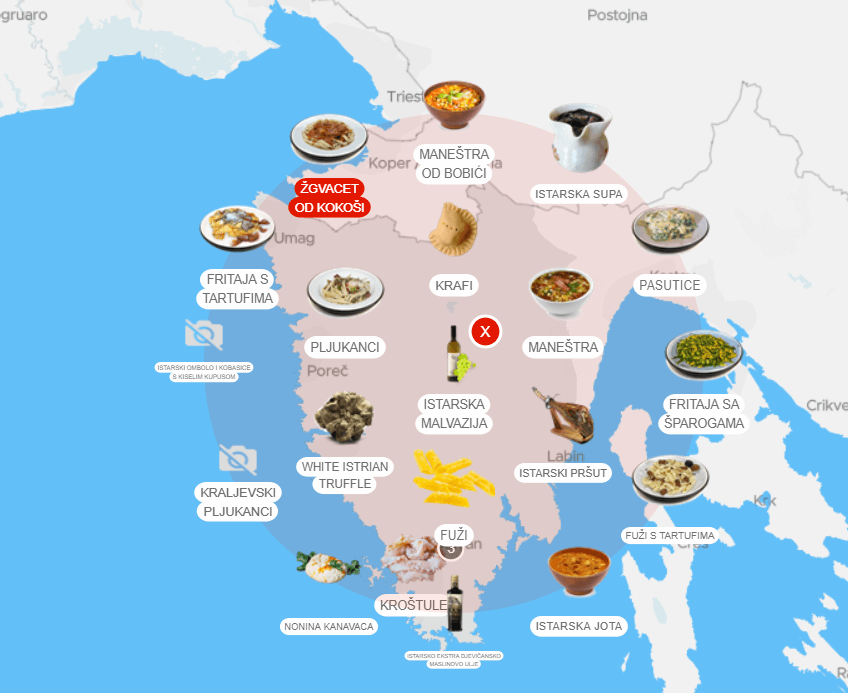
Food regions of Croatia – Dalmatia
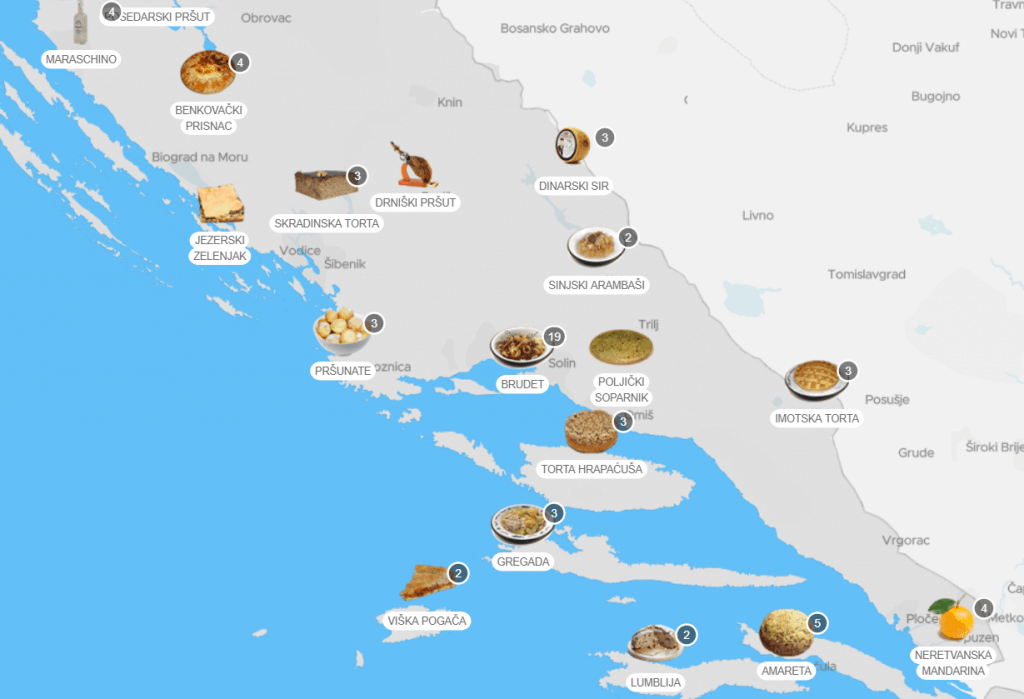
5 Croatian specialties you may not have come across
There are some weird and wonderful things to try in Croatia, which you may not have heard of, and almost certainly will not have tried elsewhere.
Soparnik
It was the ultimate peasant food, but today is one of the most sought-after Dalmatian culinary delicacies. The ingredients are very simple – flour, water, olive oil, salt, pasley, Swiss chard and garlic.
You can see how soparnik is made in the video above – check out more about this most traditional Dalmtian dish.
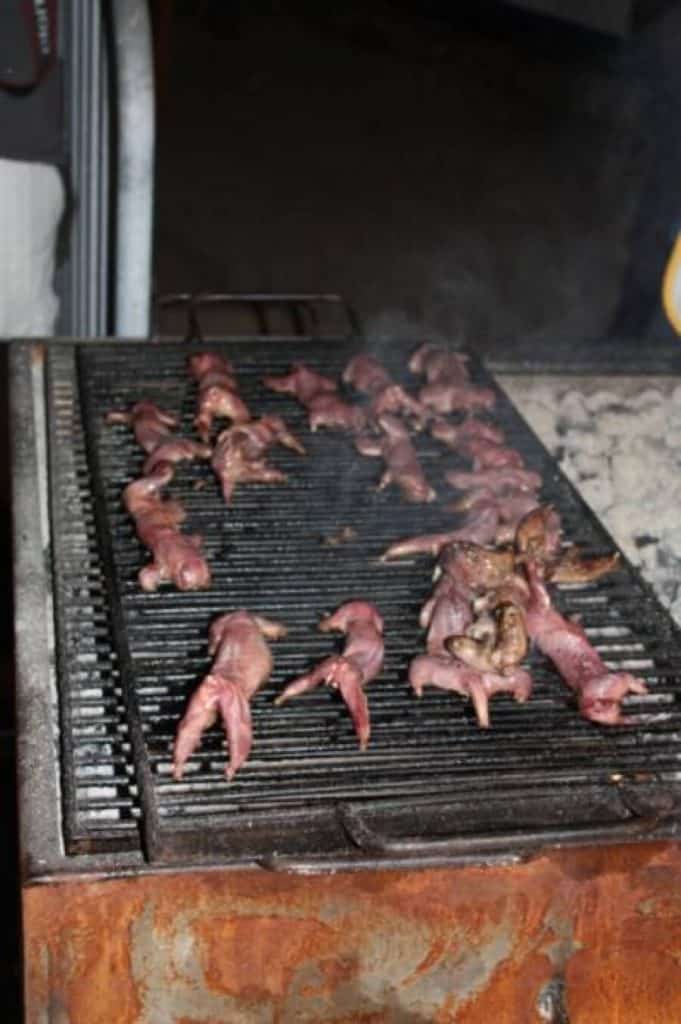
Puh (dormouse)
One of the most unusual discoveries on Hvar while researching my guidebook was the discovery of an annual dormouse festival. Not only that, but it seemed that the Puhijada was actually the biggest festival on the island.
I was curious and so I went to see what the fuss was all about. I ended up trying a couple of grilled dormice. The verdict? Extremely tasty, but very fiddly. And you certainly do not get much meat on a dormouse.
The village of Dol on Hvar and Dol on Brac are famous for their hunting and eating dormice. They are generally served grilled. There is one other place where dormice are a delicacy. The dormice in Gorski Kotar generally end up in a stew rather than on the grill.
Vitalac
If offal is your thing, then head to the island of Brac. For here you will find one of Croatian food’s most unusual dishes, which requires special skills in preparation to avoid causing illness. Learn more about vitalac, skewered and roasted lamb offal.
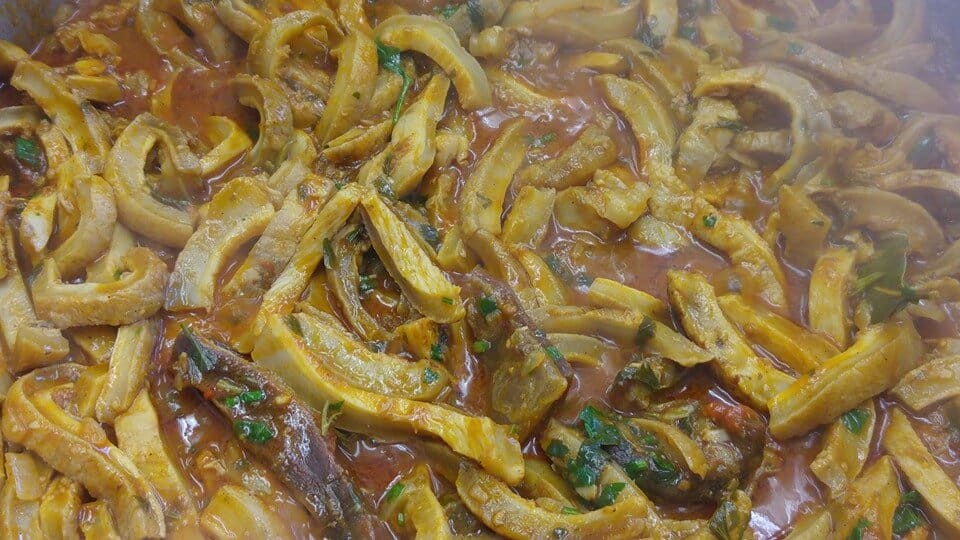
Monkfish tripe
Full disclosure on this one – I have never tried monkfish tripe. And I really hope I can get through the rest of life with that being the case. Tripe is really not my thing, but it is much loved by many in the Croatian dining world.
Monkfish tripe is apparently a particularly rare way of preparing tripe, and I confess to not knowing much more than that. A Croatian foodie friend suggested it deserved to be included in this section. There is also very little online about monkfish trip, and the best I can do for you is this recipe in Croatian.
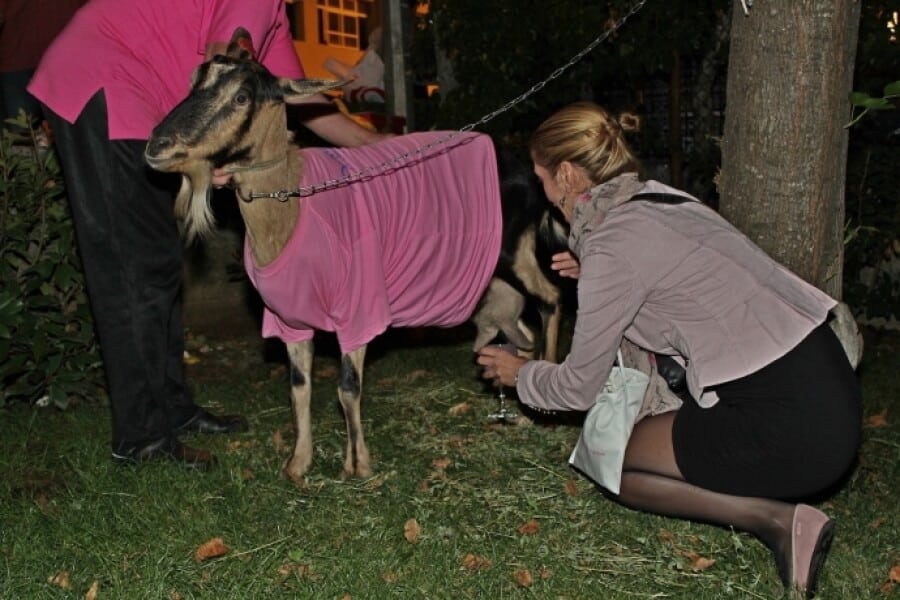
Bikla
Several years ago, I saw an old man drink what looked like strawberry milkshake, which he had poured for a plastic Coke bottle. Everyone else was drinking wine and so it struck me as somewhat strange.
I wish I hadn’t asked. For the man was drinking ‘bikla’, which is a mixture of red wine and goat milk. Yes, you read that correctly.
Bikla is apparently very common in parts of Dalmatia, and it is even served to kids. And if you happen to be near Vrgorac in October, you can pop in to the Biklijada festival. Never added goat milk to red wine directly from a goat before? Now is your chance…
Where to find recipes for Croatian dishes?
So where to go to find the recipes to make all this yummy Croatian food? There are numerous resources online. Or check out an increasing number of cookbooks dedicated to Croatian cuisine. Among some suggestions I would recommend:
- TCN has a dedicated gourmet section.
- SJ from Chasing the Donkey spends more time in the kitchen than I do. And she has some great Croatian recipes to share.
- Taste of Croatia were the original pioneers in the Croatian foodie scene.
- TasteAtlas, the first global food map, is actually run by a Croatian – check out the Croatian section.
- There has been an explosion of Croatian cookbooks in recent years, from general to niche. Find the one which suits your needs.
The Mediterranean Diet and UNESCO heritage
What can be healthier than having your diet protected by UNESCO? This is what happened to both Hvar and Brac back in 2013, as their respective Mediterranean diets were put on the Representative List of the Intangible Cultural Heritage of Humanity. The two Dalmatian islands joined several other Mediterranean destinations, and here is what UNESCO had to say:
The Mediterranean diet involves a set of skills, knowledge, rituals, symbols and traditions concerning crops, harvesting, fishing, animal husbandry, conservation, processing, cooking, and particularly the sharing and consumption of food. Eating together is the foundation of the cultural identity and continuity of communities throughout the Mediterranean basin. The Mediterranean diet emphasizes values of hospitality, neighbourliness, intercultural dialogue and creativity and plays a vital role in cultural spaces, festivals and celebrations, bringing together people of all ages, conditions and social classes.
Restaurants in Croatia: Michelin guide to something more simple
When I moved to Croatia back in 2003, there was a joke doing the rounds among the expats. There was a factory somewhere in Croatia producing restaurant menus. Once printed, all the restaurants had to do was add their name and prices. And yes, the restaurant menus really were that similar just 15 years ago.
How times change! There has been so much innovation, experimentation and new trends to the Croatian wine scene. Restaurant menus are now almost indistinguishable from that factory-produced menu of the past. A generation of celebrity chefs has added even more glamour to the Croatian gourmet scene as well.
There has also been a (for me, at least) very welcome influx of international cuisines options into the major cities (as well as some rather unusual regional additions, such as a Palestinian fast-food outlet in Sisak). This Croatian food may be wonderful, but variety is very much the spice of life.
The international gourmet guides are noticing, and Croatia is appearing in greater depth with gourmet recommendations. The first Michelin stars have been awarded to restaurants in Croatia.
And while fine dining may be on the rise, nothing beats the romance of a simple waterfront locale. A place where the wine is local, and where the menu is dictated by what is available.
Croatia has an exceptional range of restaurant experience these days, with authenticity and freshness of local ingredients at its cornerstone.
Croatian gourmet tourism: where to find culinary tours?
Croatian food and wine tourism has SO much potential. With such incredible variety and regional diversity, Croatia’s gourmet tourism should be on a par with France, Italy, Spain and Germany.
Sadly, and even despite Anthony Bourdain’s massive boost to the Croatian gastro scene, foodie tourism is still in its infancy here. It is something which has the potential to develop into a serious business. And with 12-month potential, gourmet tourism can help extend the tourism season.
There are several innovative foodie tour operators, who offer some great programmes. One idea which is gathering traction in recent years are cooking classes. There is nothing more authentic than picking your ingredients from the field or local market, and then cooking them.
I have not tried all the companies obviously, but three I can warmly recommend are Culinary Croatia, Taste of Croatia, and – for Hvar – Hvar Tours.







